 The UK energy regulator, Ofgem, has announced that the UK energy price cap will rise in October by an average of 2%. The energy price cap sets the maximum prices for electricity and gas that can be charged by suppliers to households. For those paying by direct debit, the maximum electricity price per kilowatt-hour (kWh) will rise from 25.73p to 26.35p, with the maximum daily standing charge rising from 51.37p to 53.68p. As far as gas is concerned, the maximum price per kWh will fall slightly from 6.33p to 6.29p, with the maximum daily standing charge rising from 29.82p to 34.03p. Ofgem estimates that this will mean that the capped cost to the average household will rise from £1720 to £1755.
The UK energy regulator, Ofgem, has announced that the UK energy price cap will rise in October by an average of 2%. The energy price cap sets the maximum prices for electricity and gas that can be charged by suppliers to households. For those paying by direct debit, the maximum electricity price per kilowatt-hour (kWh) will rise from 25.73p to 26.35p, with the maximum daily standing charge rising from 51.37p to 53.68p. As far as gas is concerned, the maximum price per kWh will fall slightly from 6.33p to 6.29p, with the maximum daily standing charge rising from 29.82p to 34.03p. Ofgem estimates that this will mean that the capped cost to the average household will rise from £1720 to £1755.
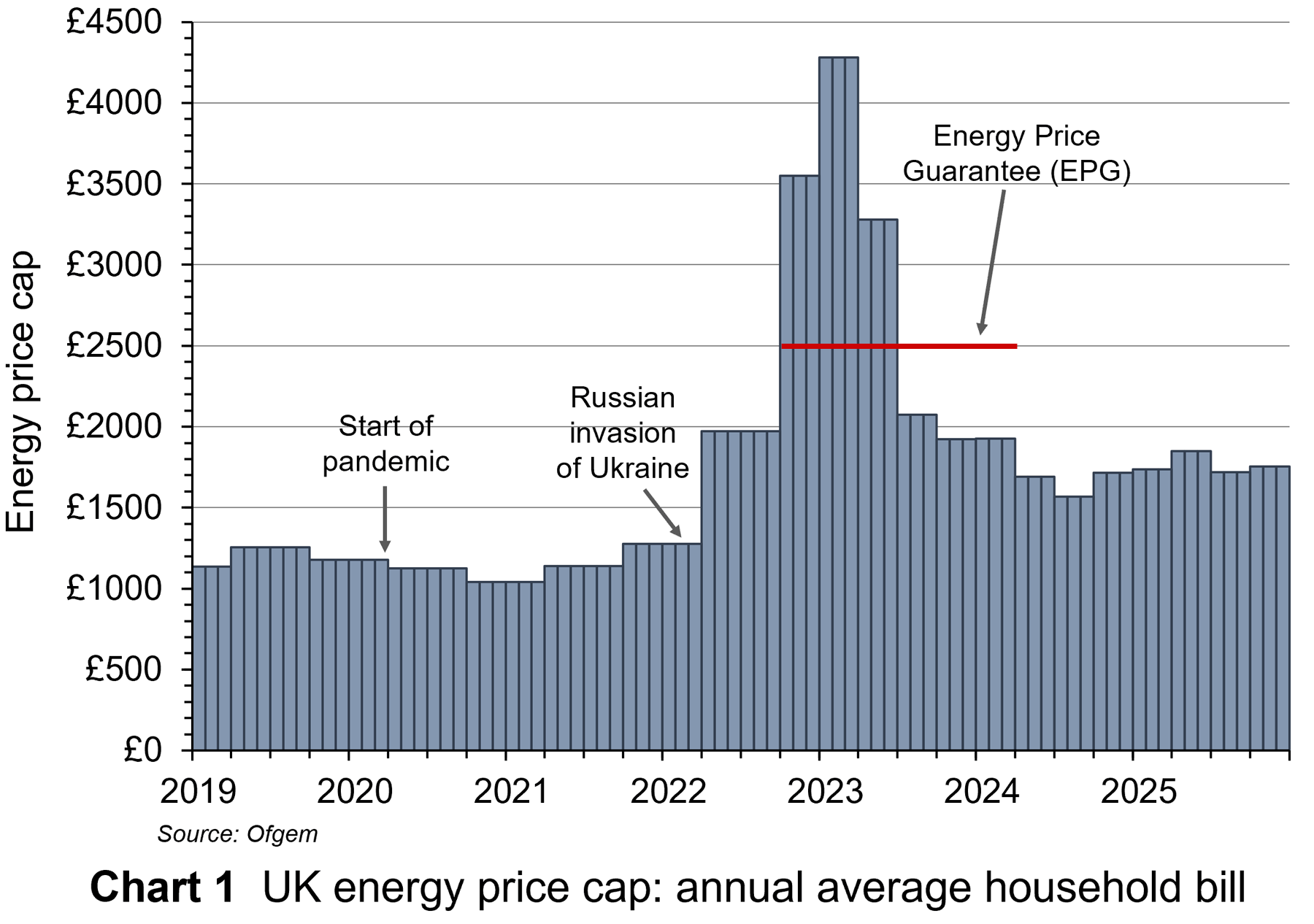 The average capped cost is now much lower than the peak of £4279 from January to March 2023. This followed the huge increase in international gas prices in the aftermath of the invasion of Ukraine and the cutting off of gas supplies from Russia. Note that although the suppliers received these capped prices, average consumers’ bills were limited to £2500 from October 2022 to March 2024 under the government’s Energy Price Guarantee scheme, with suppliers receiving a subsidy from the government to make up the shortfall. But despite today’s cap being much lower than at the peak, it is still much higher than the cap of £1277 prior to Russia’s invasion of Ukraine: see Chart 1 (click here for a PowerPoint).
The average capped cost is now much lower than the peak of £4279 from January to March 2023. This followed the huge increase in international gas prices in the aftermath of the invasion of Ukraine and the cutting off of gas supplies from Russia. Note that although the suppliers received these capped prices, average consumers’ bills were limited to £2500 from October 2022 to March 2024 under the government’s Energy Price Guarantee scheme, with suppliers receiving a subsidy from the government to make up the shortfall. But despite today’s cap being much lower than at the peak, it is still much higher than the cap of £1277 prior to Russia’s invasion of Ukraine: see Chart 1 (click here for a PowerPoint).
So is the capped price purely a reflection of the international price of gas, or is it more complicated? The picture is slightly different for gas and electricity.
Gas prices
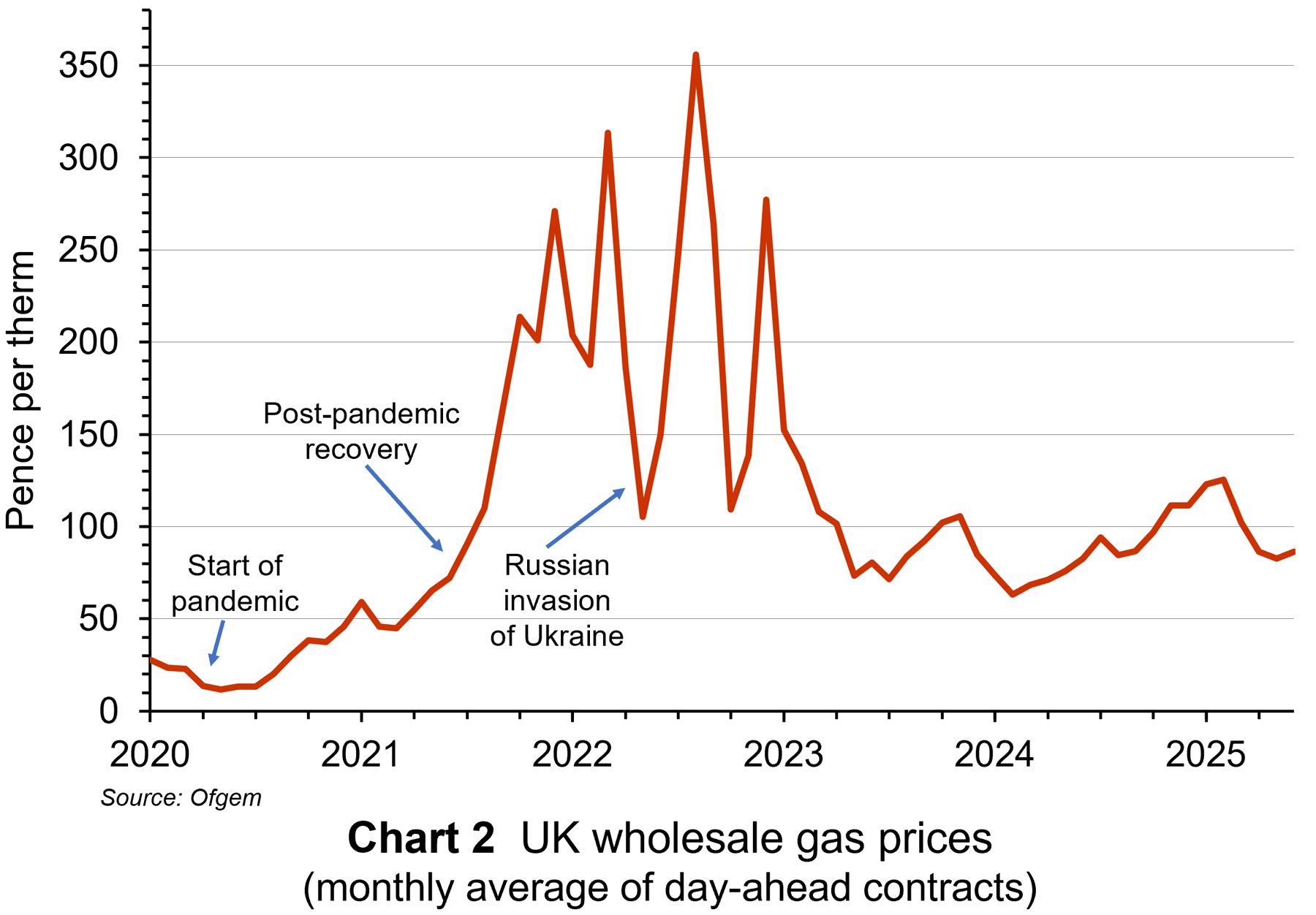 As far as gas prices are concerned, the price does largely reflect the international price: see Chart 2 (click here for a PowerPoint).
As far as gas prices are concerned, the price does largely reflect the international price: see Chart 2 (click here for a PowerPoint).
The UK is no longer self-sufficient in gas and relies in part on imported gas, with the price determined in volatile international markets. It also has low gas storage capacity compared with most other European countries. This leaves it highly reliant on volatile global markets in periods of prolonged high demand, like a cold winter. Is such cases, the UK often has to purchase more expensive liquefied natural gas (LNG) from global suppliers.
Additionally, taxes, environmental levies and the costs of the nationwide gas distribution network contribute to the overall price for consumers. Changes in these costs affect gas prices. These are itemised below in the case of electricity.
With electricity pricing, the picture is more complex.
Electricity prices
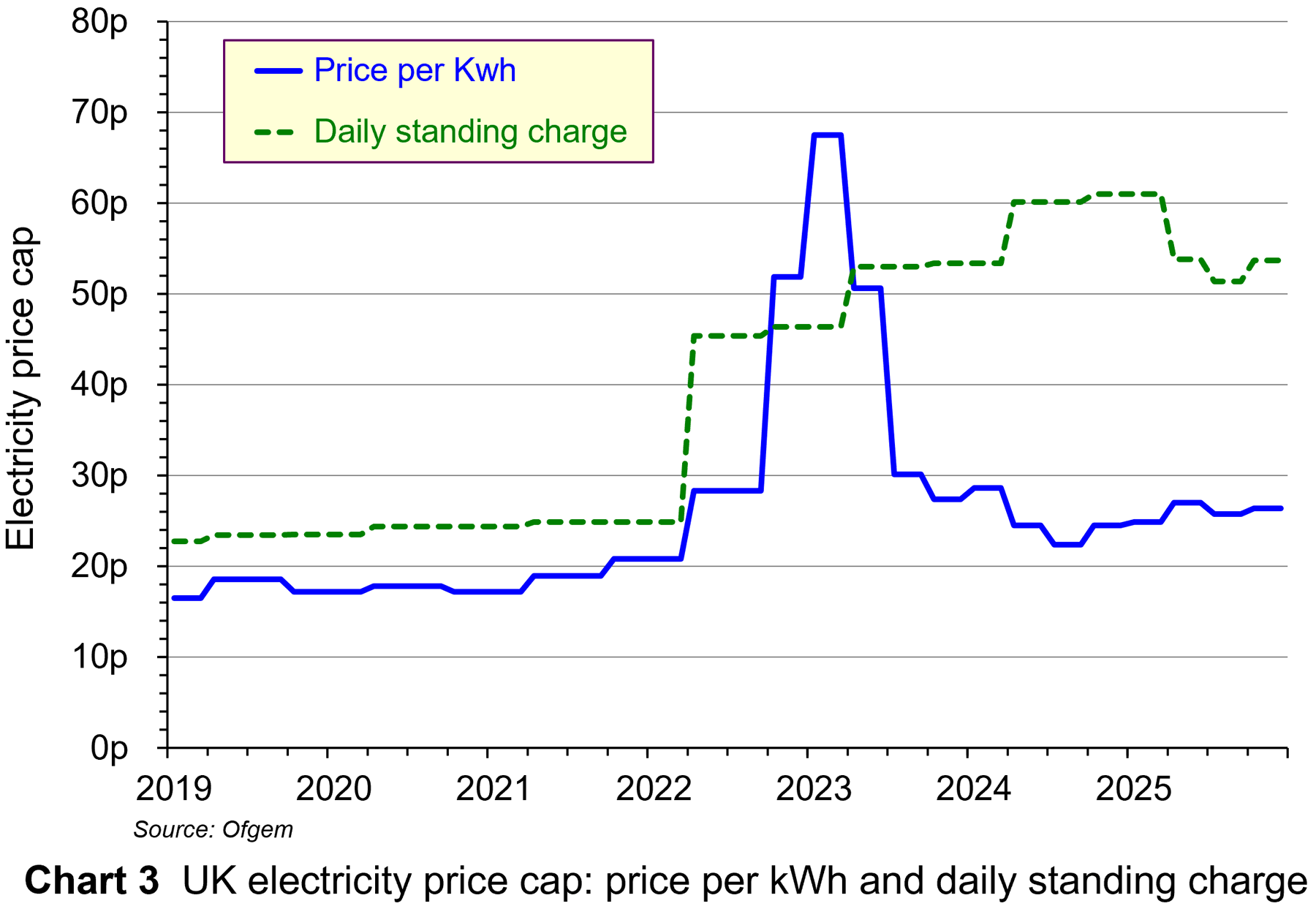 Electricity generation costs vary considerably with the different methods. Renewable sources like wind and solar have the lowest marginal costs, while natural gas plants have the highest, although gas prices fluctuate considerably.
Electricity generation costs vary considerably with the different methods. Renewable sources like wind and solar have the lowest marginal costs, while natural gas plants have the highest, although gas prices fluctuate considerably.
So how are consumer electricity prices determined? And how is the electricity price cap determined? The price cap for electricity per kWh and the daily standing charge for electricity are shown in Chart 3 (click here for a PowerPoint).
Marginal cost pricing. The wholesale price of electricity in the UK market is set by the most expensive power source needed to meet demand on a day-by-day basis. This is typically gas. This means that even when cheaper renewables (wind, solar, hydro) or nuclear power generate most of the electricity, high gas prices can increase the cost for all electricity. The wholesale price accounts for around 41% of the retail price paid by households.
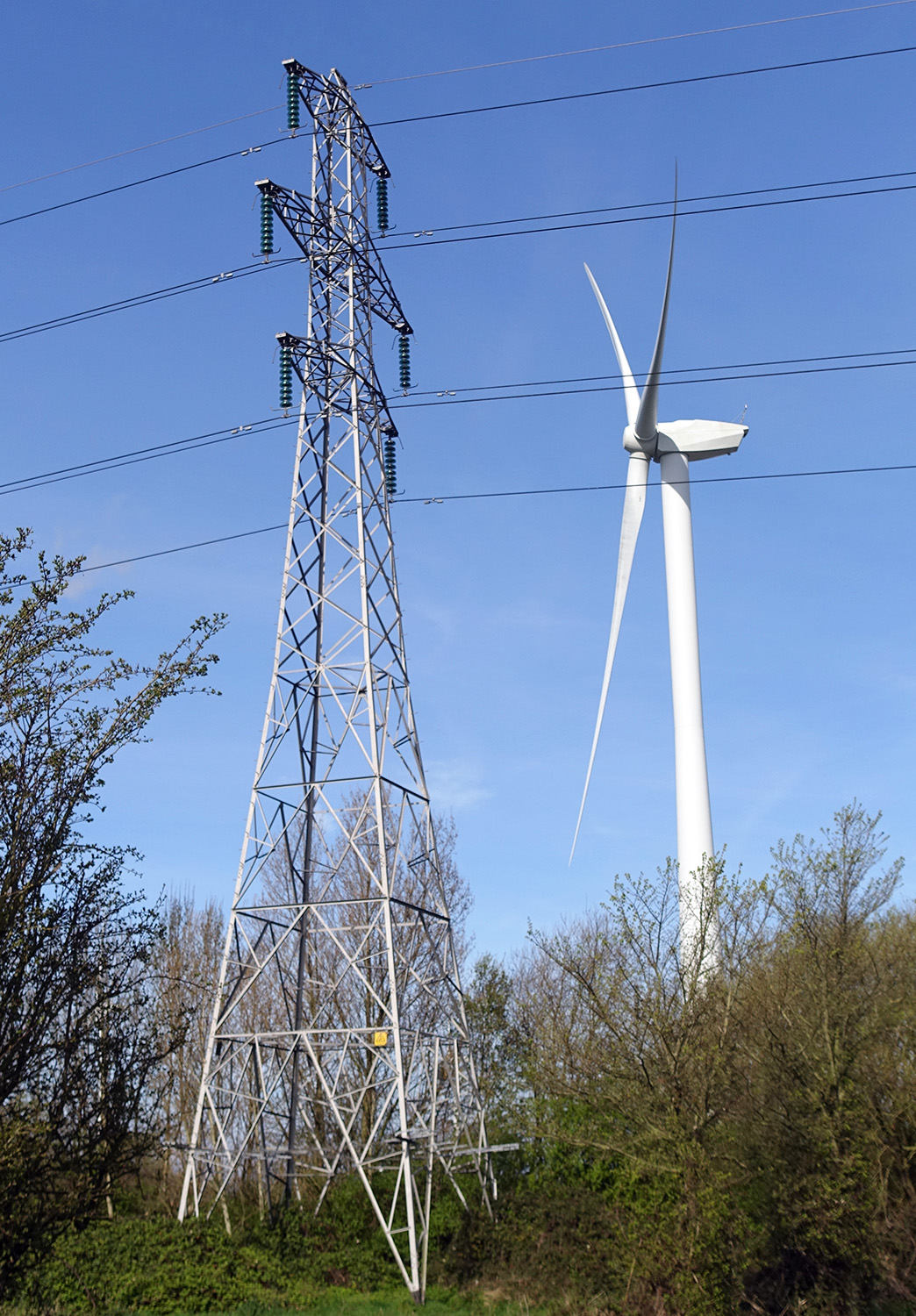 It also means that profits for low-marginal-cost producers could increase significantly when gas prices rise. To prevent such (low-carbon) suppliers making excess profits when the wholesale price is high and possibly making a loss when it is low, the actual prices that they receive is negotiated in advance and a contract is signed. These contracts are known as Contracts for Difference (CfDs). CfDs provide a fixed ‘strike price’ to low-carbon generators. The strike price is set so as to allow low-carbon generators to recoup capital costs and is thus set above the typical level of marginal cost. If the wholesale price is below the strike price, payments to generators to cover the difference are funded by amounts collected from electricity suppliers in advance using the CfD Supplier Obligation Levy. If the wholesale price is above the strike price, the difference is returned to consumers in terms of lower electricity bills.
It also means that profits for low-marginal-cost producers could increase significantly when gas prices rise. To prevent such (low-carbon) suppliers making excess profits when the wholesale price is high and possibly making a loss when it is low, the actual prices that they receive is negotiated in advance and a contract is signed. These contracts are known as Contracts for Difference (CfDs). CfDs provide a fixed ‘strike price’ to low-carbon generators. The strike price is set so as to allow low-carbon generators to recoup capital costs and is thus set above the typical level of marginal cost. If the wholesale price is below the strike price, payments to generators to cover the difference are funded by amounts collected from electricity suppliers in advance using the CfD Supplier Obligation Levy. If the wholesale price is above the strike price, the difference is returned to consumers in terms of lower electricity bills.
Policy costs. Electricity bills include an element to fund various social and environmental objectives. This element is also included in the cap. From October to December 2025, this element of the cap will be 11.3%. The money helps to subsidise low-carbon energy generation and fund energy efficiency schemes. It also funds the Warm Home Discount (WHD). In the October to December 2025 price cap, this amounted to a discount for eligible low-income and vulnerable households of £150 per annum on their electricity bills. The WHD element is included in the standing charge in the price cap. From October 2025, more generous terms will mean that the number of households receiving WHD will increase from 3.4 million to 6.1 million households. This is the main reason for the £35 increase in the cap.
Network costs. These include the cost of building, maintaining and repairing the pipes and wires that deliver gas and electricity to homes. From October to December 2025, this element of the cap will be 22.6%.
Supplier business costs. These include operating costs (billing, metering, office costs, etc.) and servicing debt. From October to December 2025, this element of the cap will be 15.4%.
Profit Allowance. A small percentage is added to the price cap for energy suppliers’ profits. This is known as the Earnings Before Interest and Tax (EBIT) allowance and is around 2.4%. This has a fixed component that does not change when the overall price cap is updated and a variable component that rises or falls with changes in the cap.
Reliance on gas, low gas storage facilities, marginal cost pricing and the commitment to invest in low-carbon electricity and home heating all add to the costs of energy in the UK, making UK electricity prices among the highest in the world.
Articles
Information and Data
Questions
- Why are the UK’s energy prices among the highest in the world?
- What are the arguments for and against subsidising wind power?
- What is the Contracts for Difference scheme in low-carbon energy. What CfDs have been awarded? Assess the desirability of the scheme.
- Is the capping of gas and electricity prices the best way of providing support for low-income and vulnerable consumers?
- How are externalities relevant in determining the optimal pricing of electricity?
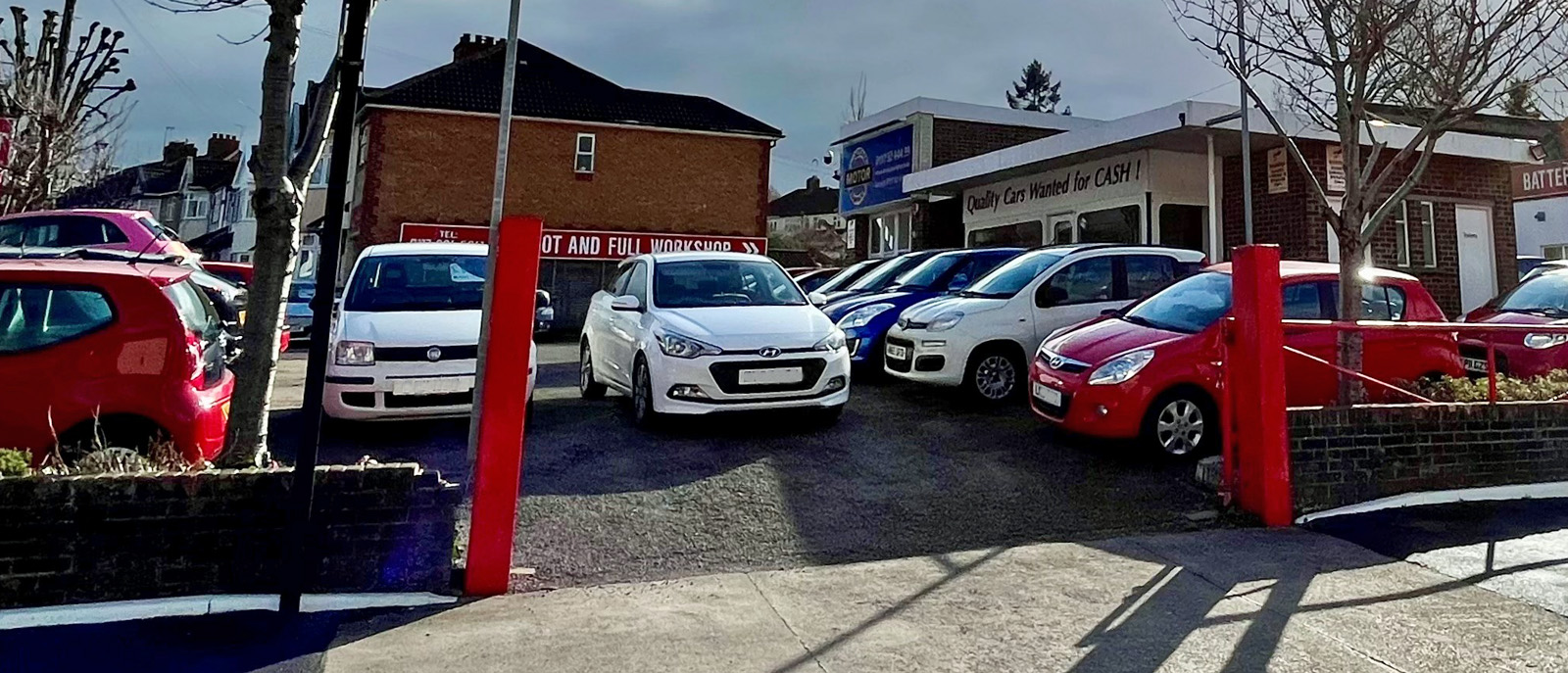 Prices of used fully electric cars (EVs) are falling in the UK, even though prices of used internal combustion engine (ICE) cars are rising. According to Auto Trader (see the first two articles below), in February 2023 the average price of used petrol cars rose by 3.3% compared with January and the price of used diesel cars rose by 1.4%. But the price of used EVs fell by 9.1%. This follows a fall of 2.1% in January.
Prices of used fully electric cars (EVs) are falling in the UK, even though prices of used internal combustion engine (ICE) cars are rising. According to Auto Trader (see the first two articles below), in February 2023 the average price of used petrol cars rose by 3.3% compared with January and the price of used diesel cars rose by 1.4%. But the price of used EVs fell by 9.1%. This follows a fall of 2.1% in January.
But why are used EV prices falling? After all, the last few years has seen a drive to replace ICEs with EVs and hybrids, with many consumers preferring electric cars to petrol and diesel ones. What is more, vehicle excise duty is currently zero for EVs (and will be until 2025) and the sale of new ICEs will be banned from the end of the decade. The answer lies in demand and supply.
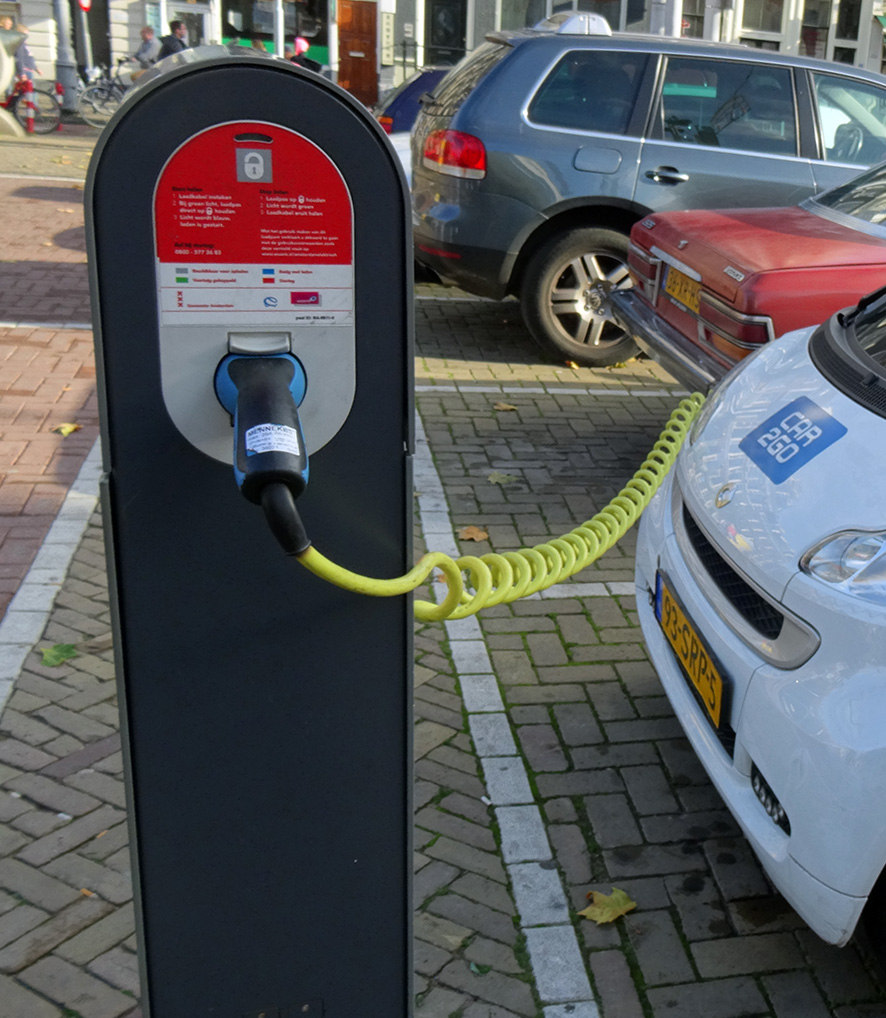 On the demand side, many existing and potential EV owners worry about the charging infrastructure. The number of EVs has grown more rapidly than the number of charging points. In 2020 there was one charging point per 16 cars; by 2022 this had worsened to one per 30 cars. Also the distribution of charging points is patchy and there is a lack of rapid and ultra-rapid chargers. Increasingly, people have to queue for access to a charger and this can substantially delay a journey and could mean missed appointments. There were many pictures in the media around Christmas of long queues for chargers at service stations and supermarkets. Poor charging infrastructure can be more of a problem for second-hand EVs, which tend to have a smaller range.
On the demand side, many existing and potential EV owners worry about the charging infrastructure. The number of EVs has grown more rapidly than the number of charging points. In 2020 there was one charging point per 16 cars; by 2022 this had worsened to one per 30 cars. Also the distribution of charging points is patchy and there is a lack of rapid and ultra-rapid chargers. Increasingly, people have to queue for access to a charger and this can substantially delay a journey and could mean missed appointments. There were many pictures in the media around Christmas of long queues for chargers at service stations and supermarkets. Poor charging infrastructure can be more of a problem for second-hand EVs, which tend to have a smaller range.
Also on the demand side is the price of fuel. After the Russian invasion of Ukraine and the rise in oil prices, the price of petrol and diesel soared. This increased the cost of running ICE vehicles and boosted the demand for EVs. But the war also drove up the price of natural gas and this price largely determines the wholesale price of electricity. With government subsidies for electricity, this constrained the rise in electricity prices. This made running an EV for a time comparatively cheaper. 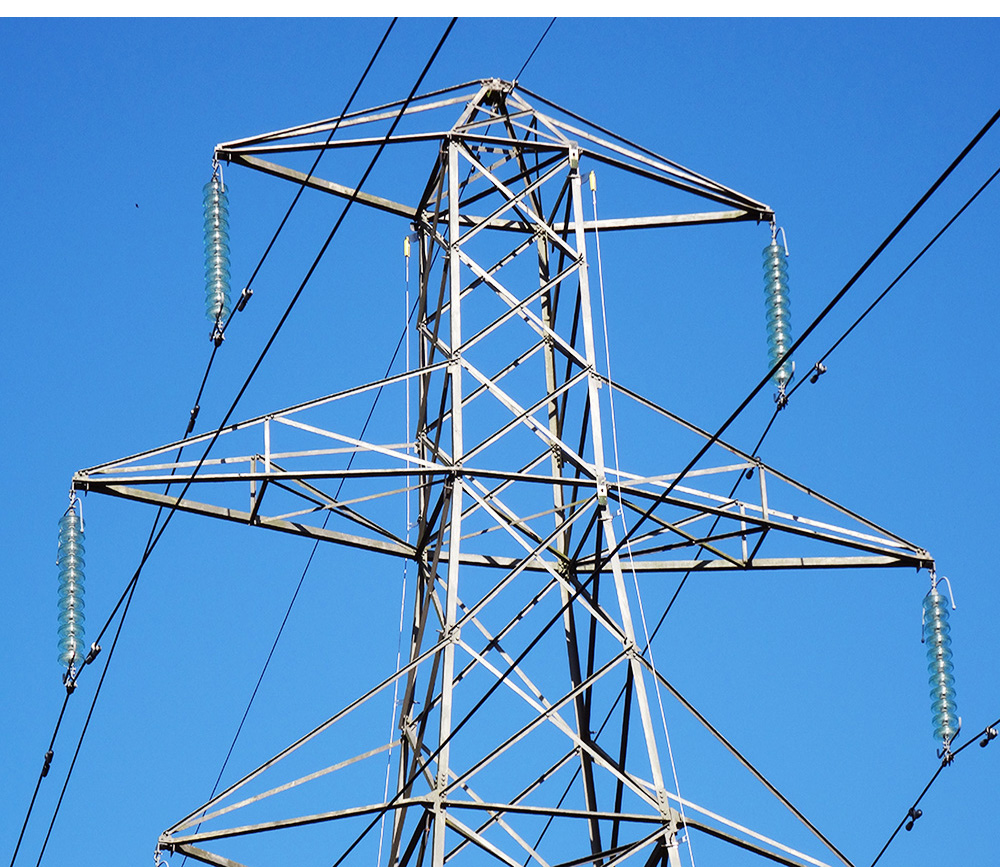 More recently, the price of oil has fallen and with it the price of petrol and diesel. But electricity prices are set to rise in April as government subsidies cease. The cost advantage of running an electric car is likely to disappear, or at least substantially decline.
More recently, the price of oil has fallen and with it the price of petrol and diesel. But electricity prices are set to rise in April as government subsidies cease. The cost advantage of running an electric car is likely to disappear, or at least substantially decline.
Another substitute for second-hand EVs is new EVs. As the range of new EVs increases, then anyone thinking about buying an EV may be more tempted to buy a new one rather than a used one. Such demand has also been driven by Tesla’s decision to cut the UK prices of many of it models by between 10% and 13%.
The fall in demand for used EVs is compounded, at least in the short term, by speculation. People thinking of trading in their ICE or hybrid car for a fully electric one are likely to wait if they see prices falling. Why buy now if, by waiting, you could get the same model cheaper?
On the supply side, EV owners, faced with the infrastructure problems outlined above, are likely to sell their EV and buy an ICE or hybrid one instead. This increases the supply of used EVs. This is again compounded by speculation as people thinking of selling their EV do so as quickly as possible before price falls further.
In many other countries, there is much more rapid investment in charging infrastructure and/or subsidies for purchasing not only new but used EVs. This has prevented or limited the fall in price of used EVs.
Articles
- Auto Trader diagnoses used car sector’s ‘robust health’ after February value rise
AM-online, Tom Sharpe (20/2/23)
- Auto Trader: Used car prices UP AGAIN in February but EV prices continue to tumble
Car Dealer, James Baggott (20/2/23)
- Used electric car prices caught in vicious downward cycle as experts warn of trouble ahead
Car Dealer, James Baggott (13/2/23)
- Used EV market needs more support in Spring Budget, says Vehicle Remarketing Association
Car Dealer, Jack Williams (15/2/23)
- Middle classes cannot afford electric cars, warns Vauxhall owner
The Telegraph, Howard Mustoe (23/2/23)
- British drivers are hurtling towards the electric car cliff edge
The Telegraph on msn, Ben Marlow (23/2/23)
- Cars Drivers should be ‘cautious’ when buying a used EV before 2030 car ban – ‘still an issue!’
Express, Felix Reeves (12/2/23)
- Motorpoint revenues accelerate but dealership group issues profit warning as used electric car prices crash
This is Money, Camilla Canocchi (27/1/23)
- Tesla cuts prices by up to a fifth to boost demand
BBC News, Lucy Hooker (13/1/23)
Questions
- Draw a supply and demand diagram to illustrate what has been happening in the market for used EVs.
- How has the price elasticity of (a) demand and (b) supply affected the amount by which used EV prices have fallen?
- Identify substitutes and complements for used electric vehicles. How relevant is the cross-price elasticity of demand for these complements and substitutes in determining price changes of used EVs?
- Draw a diagram to illustrate the effect of speculation on used EV prices.
- What is likely to happen to used EV prices in the months ahead? Explain.
- How are externalities in car usage relevant to government action to influence the market for EVs? What should determine the size of this intervention?
- Devise a short survey for people thinking of buying an EV to determine the factors that are likely to affect their decision to buy one and, if so, whether to buy a new or used one.
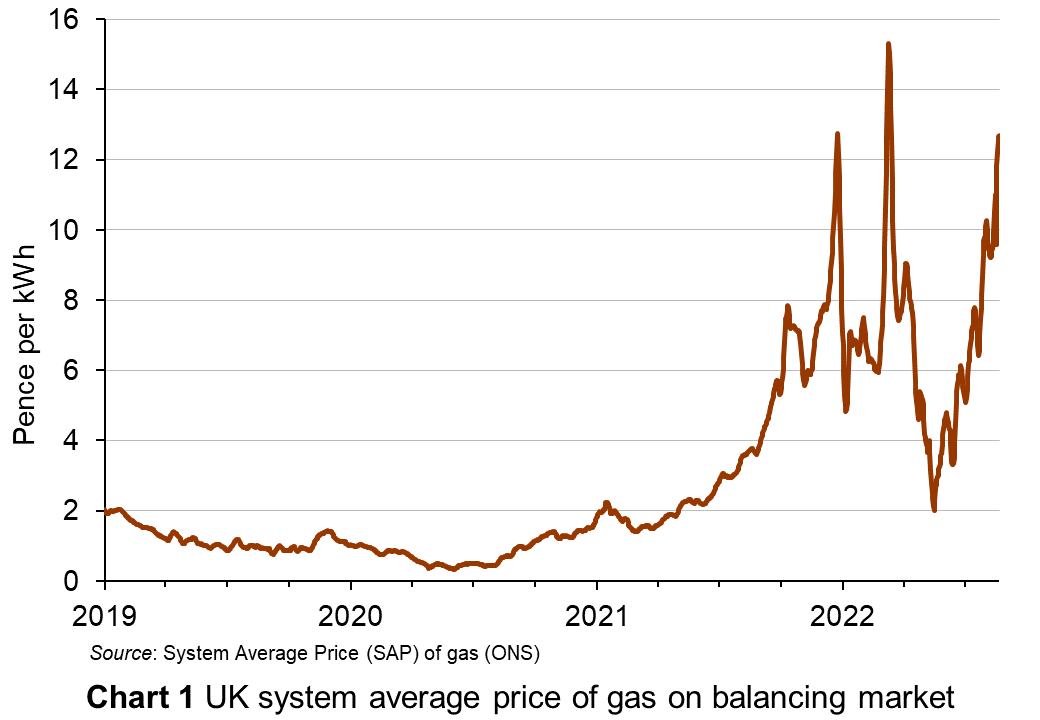 International wholesale gas prices have soared in recent months. This followed a cold winter in 2021/22 across Europe, the bounceback in demand as economies opened up after COVID and, more recently, pressure on supplies since the Russian invasion of Ukraine and the resulting restricted gas supplies from Russia. The price of gas traded on the UK wholesale market is shown in Chart 1 (click here for a PowerPoint). Analysts are forecasting that the wholesale price of gas will continue to rise for some time. The higher price of gas has had a knock-on effect on wholesale electricity prices, as gas-fired power stations are a major source of electricity generation and electricity prices.
International wholesale gas prices have soared in recent months. This followed a cold winter in 2021/22 across Europe, the bounceback in demand as economies opened up after COVID and, more recently, pressure on supplies since the Russian invasion of Ukraine and the resulting restricted gas supplies from Russia. The price of gas traded on the UK wholesale market is shown in Chart 1 (click here for a PowerPoint). Analysts are forecasting that the wholesale price of gas will continue to rise for some time. The higher price of gas has had a knock-on effect on wholesale electricity prices, as gas-fired power stations are a major source of electricity generation and electricity prices.
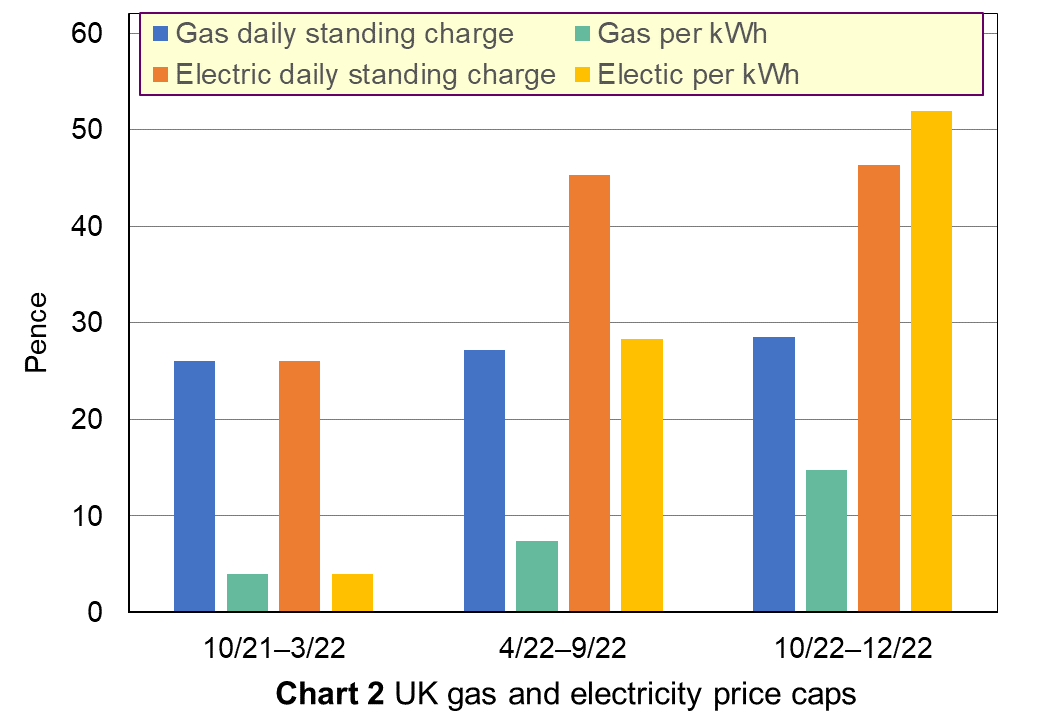 In the UK, domestic fuel prices were capped by the regulator, Ofgem. The cap reflected wholesale prices and was designed to allow electricity suppliers to make reasonable but not excessive profits. The cap was adjusted every six months, but this was been reduced to three months to reflect the rapidly changing situation. Prices are capped for both gas and electricity for both the standing charge and the rate per kilowatt hour (kWh). This is illustrated in Chart 2 (click here for a PowerPoint).
In the UK, domestic fuel prices were capped by the regulator, Ofgem. The cap reflected wholesale prices and was designed to allow electricity suppliers to make reasonable but not excessive profits. The cap was adjusted every six months, but this was been reduced to three months to reflect the rapidly changing situation. Prices are capped for both gas and electricity for both the standing charge and the rate per kilowatt hour (kWh). This is illustrated in Chart 2 (click here for a PowerPoint).
 The effects of the cap were then projected in terms of a total annual bill for a typical household consuming 12 000 kWh of gas and 2900 kWh of electricity. Chart 3 shows the typical fuel bill for the last four price caps and, prior to the mini-Budget of 23 September, the projected price caps for the first and second quarters of 2023 based on forecasts at the time of wholesale prices (click here for a PowerPoint). As you can see, wholesale gas and electricity prices account for an increasing proportion of the total bill. The remaining elements in cost consist of profits (1.9% assumed), VAT (5%), operating costs, grid connection costs and green levies (around £153). The chart shows that, without government support for prices, the price cap would have risen by 80.6% in October 2022 and was projected to rise by a further 51% in January 2023 and by another 23% in March 2023. If this were to have been the case, then prices would have risen by 481% between the summer of 2021 and March 2023.
The effects of the cap were then projected in terms of a total annual bill for a typical household consuming 12 000 kWh of gas and 2900 kWh of electricity. Chart 3 shows the typical fuel bill for the last four price caps and, prior to the mini-Budget of 23 September, the projected price caps for the first and second quarters of 2023 based on forecasts at the time of wholesale prices (click here for a PowerPoint). As you can see, wholesale gas and electricity prices account for an increasing proportion of the total bill. The remaining elements in cost consist of profits (1.9% assumed), VAT (5%), operating costs, grid connection costs and green levies (around £153). The chart shows that, without government support for prices, the price cap would have risen by 80.6% in October 2022 and was projected to rise by a further 51% in January 2023 and by another 23% in March 2023. If this were to have been the case, then prices would have risen by 481% between the summer of 2021 and March 2023.
This was leading to dire warnings of extreme fuel poverty, with huge consequences for people’s health and welfare, which would put extra demands on an already stretched health service. Many small businesses would not be able to survive the extra fuel costs, which would lead to bankruptcies and increased unemployment.
Future wholesale gas prices
 Energy market analysts expect wholesale gas prices to remain high throughout 2023, with little likelihood that gas supplies from Russia will increase. Some European countries, such as Germany, have been buying large amounts of gas to fill storage facilities before winter and before prices rise further. This has added to demand.
Energy market analysts expect wholesale gas prices to remain high throughout 2023, with little likelihood that gas supplies from Russia will increase. Some European countries, such as Germany, have been buying large amounts of gas to fill storage facilities before winter and before prices rise further. This has added to demand.
The UK, however, has only limited storage facilities. Although it is not an importer of gas from Russia and so, in one sense, storage facilities are less important at the current time, wholesale gas prices reflect international demand and supply and thus gas prices in the UK will be directly affected by an overall global shortage of supply.
What would have been the response to the projected rise in gas prices? Eventually demand would fall as substitute fuels are used for electricity generation. But demand is highly inelastic. People cannot readily switch to alternative sources of heating. Most central heating is gas fired. People may reduce consumption of energy by turning down their heating or turning it off altogether, but such reductions are likely to be a much smaller percentage than the rise in price. Thus, despite some use of other fuels and despite people cutting their energy usage, people would still end up spending much more on energy.
Over the longer term, new sources of supply of gas, including liquified natural gas (LNG), may increase supply. And switching to green energy sources for electricity generation, may bring the price of electricity back down and lead to some substitution been gas and electricity in the home and businesses. Also improved home insulation and the installation of heat pumps and solar panels in homes, especially in new builds, may reduce the demand for gas. But these changes take time. Chart 4 illustrates the situation (click here for a PowerPoint).
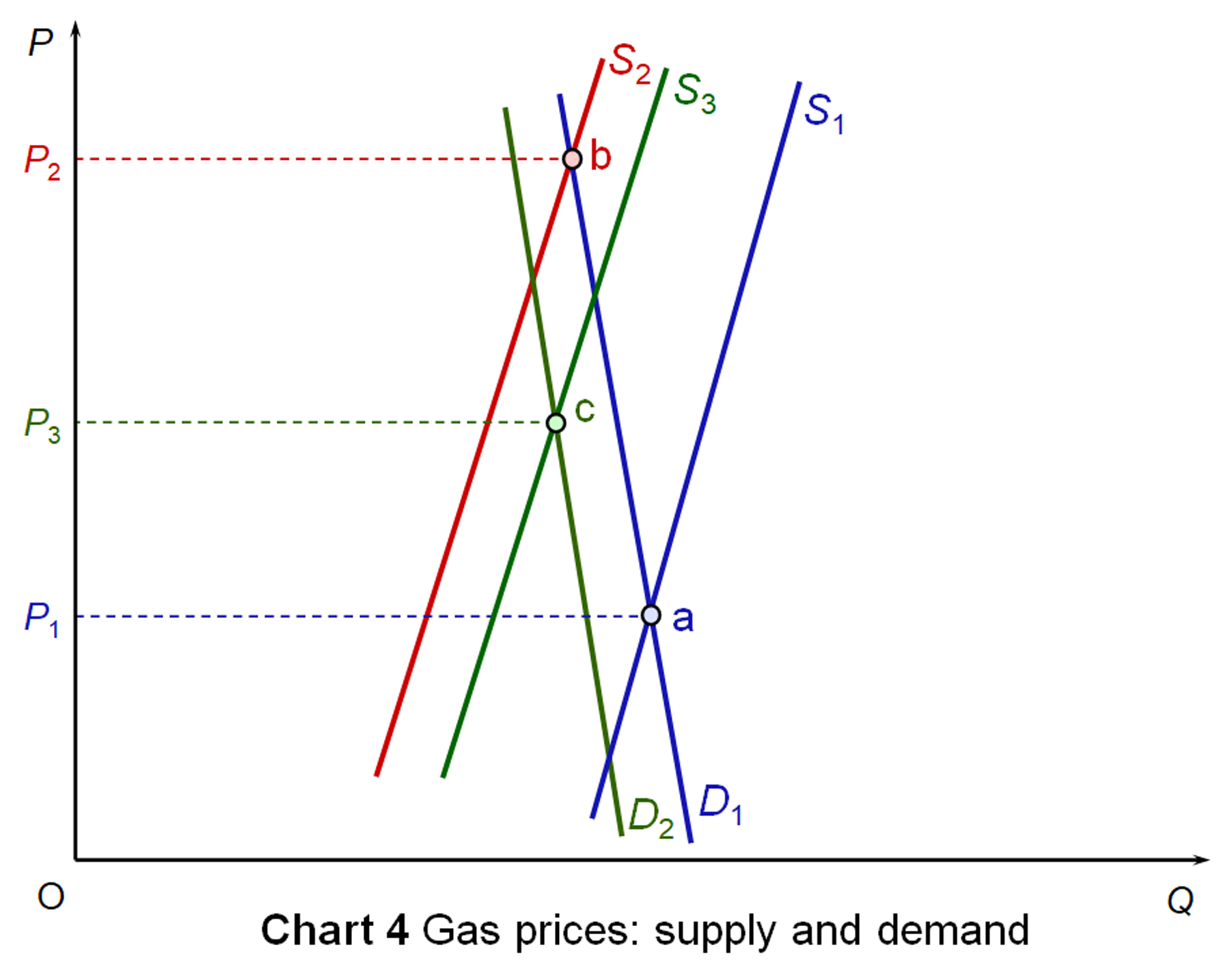 Both demand and supply are relatively inelastic. The initial demand and supply curves are D1 and S1. Equilibrium price is P1 (point a). There is now a fall in supply. Supply shifts to S2. With an inelastic demand, there is a large rise in price to P2 (point b).
Both demand and supply are relatively inelastic. The initial demand and supply curves are D1 and S1. Equilibrium price is P1 (point a). There is now a fall in supply. Supply shifts to S2. With an inelastic demand, there is a large rise in price to P2 (point b).
Over two or three years, there is a modest fall in demand (as described above) to D2 and a modest rise in supply to S3. Price falls back somewhat to P3 (point c). Over a longer period of time, these shifts would be greater and the price would fall further.
Possible policy responses
What could the government do to alleviate the problem? Consensus was that the new Conservative Prime Minister, Liz Truss, and her Chancellor, Kwasi Kwarteng, would have to take radical measures if many households were to avoid severe hardship and debt. One proposal was to reduce VAT on domestic energy from 5% to zero and to cut green levies. Although this would help, it would make only a relatively small dent in people’s rising bills.
 Another proposal was to give people cash payments to help with their bills. The more generous and widespread these payments, the more costly they would be.
Another proposal was to give people cash payments to help with their bills. The more generous and widespread these payments, the more costly they would be.
One solution here would be to impose larger windfall taxes on oil and gas producers (as opposed to retailers). Their profits have soared as oil and gas prices have soared. Such a move is generally resisted by those on the right of politics, arguing that it could discourage investment in energy production. Those on the centre and left of politics argue that the profits are the result of global factors and not because of wise business decisions by the energy producers. A windfall tax would only take away these excess profits.
The EU has agreed a tax on fossil fuel companies’ surplus profits made either this year or next. It is also introducing a levy on the excess revenues that other low-cost power producers make from higher electricity prices.
Another proposal was to freeze retail energy prices at the current or some other level. This would make it impossible for energy suppliers to cover their costs and so they would have to be subsidised. This again would be very expensive and would require substantially increased borrowing at a time when interest rates are rising, or increased taxation at a time when people’s finances are already squeezed by higher inflation. An alternative would be to cap the price North Sea producers receive. As around half of the UK’s gas consumption is from the North Sea, this would help considerably if it could be achieved, but it might be difficult to do so given that the gas is sold onto international markets.
One proposal that was gaining support from energy producers and suppliers is for the government to set up a ‘deficit fund’. Energy suppliers (retailers) would freeze energy prices for two years and take out state-backed loans from banks. These would then be paid back over time by prices being capped sufficiently high to cover costs (which, hopefully, by then would be lower) plus repayments.

Another policy response would be to decouple electricity prices from the wholesale price of gas. This is being urgently considered in the EU, and Ofgem is also consulting on such a measure. This could make wholesale electricity prices reflect the costs of the different means of generation, including wind, solar and nuclear, and would see a fall in wholesale electricity prices. At the moment, generators using these methods are making large profits.
The government’s response
On September 23, the government held a mini-Budget. One of its key elements was a capping of the unit price of energy for both households and firms. The government called this the Energy Price Guarantee. For example, those households on a variable dual-fuel, direct-debit tariff would pay no more than 34.0p/kWh for electricity and 10.3p/kWh for gas. Standing charges are capped at 46p per day for electricity and 28p per day for gas. These rates will apply for 2 years from 1/10/22 and should give an average annual household bill of £2500.
Although the government has widely referred to the ‘£2500 cap’, it is the unit price that is capped, not the annual bill. It is still the case that the more you consume, the more you will pay. As you can see from Chart 3, the average £2500 still represents an average increase per annum of just over £500 per household and is almost double the cap of £1277 a year ago. It will thus still put considerable strain on many household finances.
For businesses, prices will be capped for 6 months from 1 October at 21.1p per kWh for electricity and 7.5p per KWh for gas – considerably lower than for domestic consumers.
The government will pay subsidies to the retail energy companies to allow them to make sufficient, but not excess, profit. These subsidies are estimated to cost around £150 billion. This will be funded by borrowing, not by tax increases, with the government ruling out a windfall tax on North Sea oil and gas extracting companies. Indeed, the mini-Budget contained a number of tax reductions, including scrapping the 45% top rate of income tax, cutting the basic rate of income tax from 20% to 19% and scrapping the planned rise in corporation tax from 19% to 25%.
Articles
Data
Questions
- Why are the demand and supply of gas relatively inelastic with respect to price?
- Why are the long-run elasticities of demand and supply of gas likely to be greater than the short-run elasticities?
- Find out how wholesale electricity prices are determined. Is there a case for reforming the system and, if so, how?
- Identify ways in which people could be protected from rising energy bills.
- Assess these different methods in terms of (a) targeting help to those most in need; (b) economic efficiency.
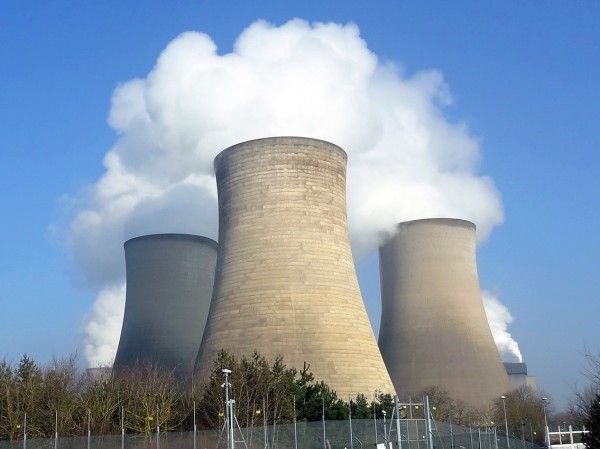 The UK energy industry (electricity and gas) is an oligopoly. There are six large suppliers: the ‘Big Six’. These are British Gas (Centrica, UK), EDF Energy (EDF, France), E.ON UK (E.ON, Germany), npower (RWE, Germany), Scottish Power (Iberdrola, Spain) and SSE (SSE Group, UK). The Big Six supply around 73% of the total UK market and around 90% of the domestic market.
The UK energy industry (electricity and gas) is an oligopoly. There are six large suppliers: the ‘Big Six’. These are British Gas (Centrica, UK), EDF Energy (EDF, France), E.ON UK (E.ON, Germany), npower (RWE, Germany), Scottish Power (Iberdrola, Spain) and SSE (SSE Group, UK). The Big Six supply around 73% of the total UK market and around 90% of the domestic market.
Energy suppliers buy wholesale gas and electricity and sell it to customers. The industry has a considerable degree of vertical integration, with the energy suppliers also being involved in both generation and local distribution (long-distance distribution through the familiar pylons is by National Grid). There is also considerable horizontal integration, with energy suppliers supplying both electricity and gas and offering ‘dual-fuel’ deals, whereby customers get a discount by buying both fuels from the same supplier.
Smaller suppliers have complained about substantial barriers to entry in the industry. In particular, they normally have to buy wholesale from one of the Big Six. Lack of transparency concerning their costs and internal transfer prices by the Big Six has led to suspicions that they are charging more to independent suppliers than to themselves.
 Under new regulations announced by Ofgem, the industry regulator, the Big Six will have to post the prices at which they will trade wholesale power two years in advance and must trade fairly with independent suppliers or face financial penalties. In addition, ‘a range of measures will make the annual statements of the large companies more robust, useful and accessible.’ According to the Ofgem Press Release:
Under new regulations announced by Ofgem, the industry regulator, the Big Six will have to post the prices at which they will trade wholesale power two years in advance and must trade fairly with independent suppliers or face financial penalties. In addition, ‘a range of measures will make the annual statements of the large companies more robust, useful and accessible.’ According to the Ofgem Press Release:
From 31 March new rules come into force meaning the six largest suppliers and the largest independent generators will have to trade fairly with independent suppliers in the wholesale market, or face financial penalties. The six largest suppliers will also have to publish the price at which they will trade wholesale power up to two years in advance. These prices must be published daily in two one-hour windows, giving independent suppliers and generators the opportunity and products they need to trade and compete effectively.
But will these measures be enough to break down the barriers to entry in the industry and make the market genuinely competitive? The following articles look at the issue.
Articles
Boost for small energy firms as Big Six are ordered to trade fairly on wholesale markets or face multi-million pound fines This is Money, Rachel Rickard Straus (26/2/14)
 Energy firms told to trade fairly with smaller rivals BBC News, Rachel Fletcher (26/2/14)
Energy firms told to trade fairly with smaller rivals BBC News, Rachel Fletcher (26/2/14)
Ofgem ramps up scrutiny of Big Six accounts The Telegraph, Denise Roland (26/2/14)
‘Big six’ told to trade fairly – will it make a difference? Channel 4 News, Emma Maxwell (26/2/14)
Energy regulator Ofgem forces trading rules on ‘big six’ suppliers Financial Times, Andy Sharman (26/2/14)
Information
Ofgem tears down barriers to competition to bear down as hard as possible on energy prices Ofgem Press Release (26/2/14)
The energy market explained Energy UK
Gas Ofgem
Electricity Ofgem
Energy in the United Kingdom Wikipedia
Big Six Energy Suppliers (UK) Wikipedia
Questions
- Describe the structure of the UK energy industry.
- What are the barriers to the entry of new energy suppliers and generators in the UK?
- To what extent is vertical integration in the electricity generation and supply industry in the interests of consumers?
- To what extent is horizontal integration in the electricity and gas markets in the interests of consumers?
- How will requiring the six largest energy suppliers to post their wholesale prices for the next 24 months increase competition in the energy market?
- Is greater transparency about the revenues, costs and profits of energy suppliers likely to make the market more competitive?
- Identify and discuss other measures which Ofgem could introduce to make the energy market more competitive.
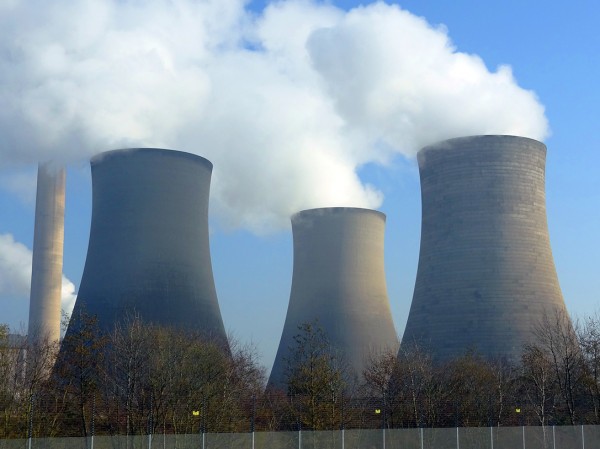 The energy market is complex and is a prime example of an oligopoly: a few dominant firms in the market and interdependence between the suppliers. Over 95% of the market is supplied by the so-called ‘big six’ and collectively they generate 80% of the country’s electricity. There are two further large generators (Drax Power Limited and GDF Suez Energy UK), meaning the electricity generation is also an oligopoly.
The energy market is complex and is a prime example of an oligopoly: a few dominant firms in the market and interdependence between the suppliers. Over 95% of the market is supplied by the so-called ‘big six’ and collectively they generate 80% of the country’s electricity. There are two further large generators (Drax Power Limited and GDF Suez Energy UK), meaning the electricity generation is also an oligopoly.
This sector has seen media attention for some years, with criticisms about the high profits made by suppliers, the high prices they charge and the lack of competition. Numerous investigations have taken place by Ofgem, the energy market regulator, and the latest development builds on a simple concept that has been a known problem for decades: barriers to entry. It is very difficult for new firms to enter this market, in particular because of the vertically integrated nature of the big six. Not only are they the suppliers of the energy, but they are also the energy generators. It is therefore very difficult for new suppliers to enter the market and access the energy that is generated.
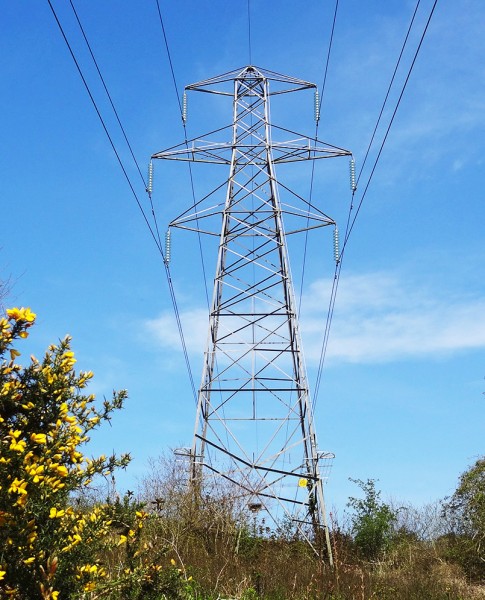 Ofgem’s new plans will aim to reduce the barriers to entry in the market and thus make it easier for new firms to enter and act as effective competitors. The big six energy generators are vertically integrated companies and thus effectively sell their energy to themselves, whereas other suppliers have to purchase their energy before they can sell it. The regulator’s plans aim to improve transparency by ensuring that wholesale power prices are published two years in advance, thus making it easier for smaller companies to buy energy and then re-sell it. Andrew Wright, the Chief Executive of Ofgem, said:
Ofgem’s new plans will aim to reduce the barriers to entry in the market and thus make it easier for new firms to enter and act as effective competitors. The big six energy generators are vertically integrated companies and thus effectively sell their energy to themselves, whereas other suppliers have to purchase their energy before they can sell it. The regulator’s plans aim to improve transparency by ensuring that wholesale power prices are published two years in advance, thus making it easier for smaller companies to buy energy and then re-sell it. Andrew Wright, the Chief Executive of Ofgem, said:
These reforms give independent suppliers, generators and new entrants to the market, both the visibility of prices, and [the] opportunities to trade, [that] they need to compete with the largest energy suppliers…Almost two million customers are with independent suppliers, and we expect these reforms to help these suppliers and any new entrants to grow.
Although such reforms will reduce the barriers to entry in the market and thus should aim to increase competition and hence benefit consumers, many argue that the reforms don’t go far enough and will have only minor effects on the competitiveness in the market. There are still calls for further reforms in the market and a more in-depth investigation to ensure that consumers are really getting the best deal. The following articles consider this ongoing saga and this highly complex market.
Ofgem ramps up scrutiny of Big six accounts Telegraph, Denise Roland (27/2/14)
 Energy firms told to trade fairly with smaller rivals BBC News (26/2/14)
Energy firms told to trade fairly with smaller rivals BBC News (26/2/14)
Energy regulator Ofgem force trading rules on ‘big six’ suppliers Financial Times, Andy Sharman (26/2/14)
Ed Davey calls on Ofgem to investigate energy firms’ gas profits The Guardian, Sean Farrell and Jennifer Rankin (10/2/14)
UK forces big power companies to reveal wholesale prices Reuters (26/2/14)
Watchdog unveils new rules on Big six energy prices Independent, Tom Bawden (26/2/14)
Energy Bills: New rules to boost competition Sky News, (26/2/14)
Questions
- What are the characteristics of an oligopoly?
- Explain the reason why the vertically integrated nature of the big six energy companies creates a barrier to the entry of new firms.
- What are the barriers to entry in (a) the electricity supply market and (b) the electricity generating market?
- What action has Ofgem suggested to increase competition in the market? How effective are the proposals likely to be/
- Why is there a concern about liquidity in the market?
- If barriers to entry are reduced, how will this affect competition in the market? How will consumers be affected?
- Why are there suggestions that Ofgem’s proposals don’t go far enough?
 The UK energy regulator, Ofgem, has announced that the UK energy price cap will rise in October by an average of 2%. The energy price cap sets the maximum prices for electricity and gas that can be charged by suppliers to households. For those paying by direct debit, the maximum electricity price per kilowatt-hour (kWh) will rise from 25.73p to 26.35p, with the maximum daily standing charge rising from 51.37p to 53.68p. As far as gas is concerned, the maximum price per kWh will fall slightly from 6.33p to 6.29p, with the maximum daily standing charge rising from 29.82p to 34.03p. Ofgem estimates that this will mean that the capped cost to the average household will rise from £1720 to £1755.
The UK energy regulator, Ofgem, has announced that the UK energy price cap will rise in October by an average of 2%. The energy price cap sets the maximum prices for electricity and gas that can be charged by suppliers to households. For those paying by direct debit, the maximum electricity price per kilowatt-hour (kWh) will rise from 25.73p to 26.35p, with the maximum daily standing charge rising from 51.37p to 53.68p. As far as gas is concerned, the maximum price per kWh will fall slightly from 6.33p to 6.29p, with the maximum daily standing charge rising from 29.82p to 34.03p. Ofgem estimates that this will mean that the capped cost to the average household will rise from £1720 to £1755. The average capped cost is now much lower than the peak of £4279 from January to March 2023. This followed the huge increase in international gas prices in the aftermath of the invasion of Ukraine and the cutting off of gas supplies from Russia. Note that although the suppliers received these capped prices, average consumers’ bills were limited to £2500 from October 2022 to March 2024 under the government’s Energy Price Guarantee scheme, with suppliers receiving a subsidy from the government to make up the shortfall. But despite today’s cap being much lower than at the peak, it is still much higher than the cap of £1277 prior to Russia’s invasion of Ukraine: see Chart 1 (click here for a PowerPoint).
The average capped cost is now much lower than the peak of £4279 from January to March 2023. This followed the huge increase in international gas prices in the aftermath of the invasion of Ukraine and the cutting off of gas supplies from Russia. Note that although the suppliers received these capped prices, average consumers’ bills were limited to £2500 from October 2022 to March 2024 under the government’s Energy Price Guarantee scheme, with suppliers receiving a subsidy from the government to make up the shortfall. But despite today’s cap being much lower than at the peak, it is still much higher than the cap of £1277 prior to Russia’s invasion of Ukraine: see Chart 1 (click here for a PowerPoint). As far as gas prices are concerned, the price does largely reflect the international price: see Chart 2 (click here for a PowerPoint).
As far as gas prices are concerned, the price does largely reflect the international price: see Chart 2 (click here for a PowerPoint). Electricity generation costs vary considerably with the different methods. Renewable sources like wind and solar have the lowest marginal costs, while natural gas plants have the highest, although gas prices fluctuate considerably.
Electricity generation costs vary considerably with the different methods. Renewable sources like wind and solar have the lowest marginal costs, while natural gas plants have the highest, although gas prices fluctuate considerably.  It also means that profits for low-marginal-cost producers could increase significantly when gas prices rise. To prevent such (low-carbon) suppliers making excess profits when the wholesale price is high and possibly making a loss when it is low, the actual prices that they receive is negotiated in advance and a contract is signed. These contracts are known as Contracts for Difference (CfDs). CfDs provide a fixed ‘strike price’ to low-carbon generators. The strike price is set so as to allow low-carbon generators to recoup capital costs and is thus set above the typical level of marginal cost. If the wholesale price is below the strike price, payments to generators to cover the difference are funded by amounts collected from electricity suppliers in advance using the CfD Supplier Obligation Levy. If the wholesale price is above the strike price, the difference is returned to consumers in terms of lower electricity bills.
It also means that profits for low-marginal-cost producers could increase significantly when gas prices rise. To prevent such (low-carbon) suppliers making excess profits when the wholesale price is high and possibly making a loss when it is low, the actual prices that they receive is negotiated in advance and a contract is signed. These contracts are known as Contracts for Difference (CfDs). CfDs provide a fixed ‘strike price’ to low-carbon generators. The strike price is set so as to allow low-carbon generators to recoup capital costs and is thus set above the typical level of marginal cost. If the wholesale price is below the strike price, payments to generators to cover the difference are funded by amounts collected from electricity suppliers in advance using the CfD Supplier Obligation Levy. If the wholesale price is above the strike price, the difference is returned to consumers in terms of lower electricity bills. Is Trump right about wind power and UK energy bills?
Is Trump right about wind power and UK energy bills? Prices of used fully electric cars (EVs) are falling in the UK, even though prices of used internal combustion engine (ICE) cars are rising. According to Auto Trader (see the first two articles below), in February 2023 the average price of used petrol cars rose by 3.3% compared with January and the price of used diesel cars rose by 1.4%. But the price of used EVs fell by 9.1%. This follows a fall of 2.1% in January.
Prices of used fully electric cars (EVs) are falling in the UK, even though prices of used internal combustion engine (ICE) cars are rising. According to Auto Trader (see the first two articles below), in February 2023 the average price of used petrol cars rose by 3.3% compared with January and the price of used diesel cars rose by 1.4%. But the price of used EVs fell by 9.1%. This follows a fall of 2.1% in January. On the demand side, many existing and potential EV owners worry about the charging infrastructure. The number of EVs has grown more rapidly than the number of charging points. In 2020 there was one charging point per 16 cars; by 2022 this had worsened to one per 30 cars. Also the distribution of charging points is patchy and there is a lack of rapid and ultra-rapid chargers. Increasingly, people have to queue for access to a charger and this can substantially delay a journey and could mean missed appointments. There were many pictures in the media around Christmas of long queues for chargers at service stations and supermarkets. Poor charging infrastructure can be more of a problem for second-hand EVs, which tend to have a smaller range.
On the demand side, many existing and potential EV owners worry about the charging infrastructure. The number of EVs has grown more rapidly than the number of charging points. In 2020 there was one charging point per 16 cars; by 2022 this had worsened to one per 30 cars. Also the distribution of charging points is patchy and there is a lack of rapid and ultra-rapid chargers. Increasingly, people have to queue for access to a charger and this can substantially delay a journey and could mean missed appointments. There were many pictures in the media around Christmas of long queues for chargers at service stations and supermarkets. Poor charging infrastructure can be more of a problem for second-hand EVs, which tend to have a smaller range. More recently, the price of oil has fallen and with it the price of petrol and diesel. But electricity prices are set to rise in April as government subsidies cease. The cost advantage of running an electric car is likely to disappear, or at least substantially decline.
More recently, the price of oil has fallen and with it the price of petrol and diesel. But electricity prices are set to rise in April as government subsidies cease. The cost advantage of running an electric car is likely to disappear, or at least substantially decline. International wholesale gas prices have soared in recent months. This followed a cold winter in 2021/22 across Europe, the bounceback in demand as economies opened up after COVID and, more recently, pressure on supplies since the Russian invasion of Ukraine and the resulting restricted gas supplies from Russia. The price of gas traded on the UK wholesale market is shown in Chart 1 (click
International wholesale gas prices have soared in recent months. This followed a cold winter in 2021/22 across Europe, the bounceback in demand as economies opened up after COVID and, more recently, pressure on supplies since the Russian invasion of Ukraine and the resulting restricted gas supplies from Russia. The price of gas traded on the UK wholesale market is shown in Chart 1 (click  In the UK, domestic fuel prices were capped by the regulator, Ofgem. The cap reflected wholesale prices and was designed to allow electricity suppliers to make reasonable but not excessive profits. The cap was adjusted every six months, but this was been reduced to three months to reflect the rapidly changing situation. Prices are capped for both gas and electricity for both the standing charge and the rate per kilowatt hour (kWh). This is illustrated in Chart 2 (click
In the UK, domestic fuel prices were capped by the regulator, Ofgem. The cap reflected wholesale prices and was designed to allow electricity suppliers to make reasonable but not excessive profits. The cap was adjusted every six months, but this was been reduced to three months to reflect the rapidly changing situation. Prices are capped for both gas and electricity for both the standing charge and the rate per kilowatt hour (kWh). This is illustrated in Chart 2 (click  The effects of the cap were then projected in terms of a total annual bill for a typical household consuming 12 000 kWh of gas and 2900 kWh of electricity. Chart 3 shows the typical fuel bill for the last four price caps and, prior to the mini-Budget of 23 September, the projected price caps for the first and second quarters of 2023 based on forecasts at the time of wholesale prices (click
The effects of the cap were then projected in terms of a total annual bill for a typical household consuming 12 000 kWh of gas and 2900 kWh of electricity. Chart 3 shows the typical fuel bill for the last four price caps and, prior to the mini-Budget of 23 September, the projected price caps for the first and second quarters of 2023 based on forecasts at the time of wholesale prices (click  Energy market analysts expect wholesale gas prices to remain high throughout 2023, with little likelihood that gas supplies from Russia will increase. Some European countries, such as Germany, have been buying large amounts of gas to fill storage facilities before winter and before prices rise further. This has added to demand.
Energy market analysts expect wholesale gas prices to remain high throughout 2023, with little likelihood that gas supplies from Russia will increase. Some European countries, such as Germany, have been buying large amounts of gas to fill storage facilities before winter and before prices rise further. This has added to demand.  Both demand and supply are relatively inelastic. The initial demand and supply curves are D1 and S1. Equilibrium price is P1 (point a). There is now a fall in supply. Supply shifts to S2. With an inelastic demand, there is a large rise in price to P2 (point b).
Both demand and supply are relatively inelastic. The initial demand and supply curves are D1 and S1. Equilibrium price is P1 (point a). There is now a fall in supply. Supply shifts to S2. With an inelastic demand, there is a large rise in price to P2 (point b).  Another proposal was to give people cash payments to help with their bills. The more generous and widespread these payments, the more costly they would be.
Another proposal was to give people cash payments to help with their bills. The more generous and widespread these payments, the more costly they would be.



